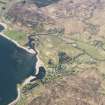Pricing Change
New pricing for orders of material from this site will come into place shortly. Charges for supply of digital images, digitisation on demand, prints and licensing will be altered.
Upcoming Maintenance
Please be advised that this website will undergo scheduled maintenance on the following dates:
Thursday, 9 January: 11:00 AM - 3:00 PM
Thursday, 23 January: 11:00 AM - 3:00 PM
Thursday, 30 January: 11:00 AM - 3:00 PM
During these times, some functionality such as image purchasing may be temporarily unavailable. We apologise for any inconvenience this may cause.
Glenelg Village, Drumtearn
Officers Quarters (18th Century)
Site Name Glenelg Village, Drumtearn
Classification Officers Quarters (18th Century)
Alternative Name(s) Former Drumfern Officers Quarters
Canmore ID 238705
Site Number NG81NW 58
NGR NG 81389 19393
Datum OSGB36 - NGR
Permalink http://canmore.org.uk/site/238705
- Council Highland
- Parish Glenelg (Skye And Lochalsh)
- Former Region Highland
- Former District Skye And Lochalsh
- Former County Inverness-shire
(Kirkton of) Glenelg. In 1786 John Knox described Glenelg as 'inhabited by 900 people, having a church, a manse, a public house, with a groupe of mean huts, and the most miserable looking people that I had seen...'; he continued with the advice that 'there are few places in the Highlands where the benefits of a town would be more generally felt than at this place'. Two years later the village had been 'lately planned out' for Macleod of Macleod, who desired to establish a 'manufacture for coarse cloths' here. A sturdy pair of terraces facing each other across Main Street were erected at this time and remain a distinguishing feature, the austerity of their whitewashed and slated fronts eased with the later addition of gabled porches and tiny gardens. In 1848 there were 148 families living in Kirkton; today it is a quiet backwater. The short main street, still approached by a handsome tree-lined avenue, is completed with a few 19th and 20th century harled cottage.
Taken from "Western Seaboard: An Illustrated Architectural Guide", by Mary Miers, 2007. Published by the Rutland Press http://www.rias.org.uk









